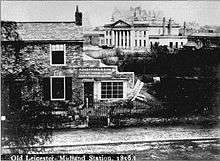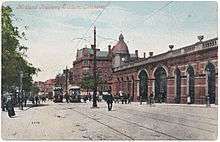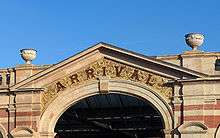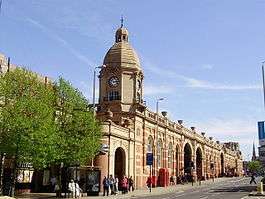Leicester railway station
| Leicester | |
|---|---|
|
Leicester railway station as seen from London Road (Northern Entrance) | |
| Location | |
| Place | Leicester |
| Local authority | City of Leicester |
| Coordinates | 52°37′55″N 1°07′26″W / 52.632°N 1.124°WCoordinates: 52°37′55″N 1°07′26″W / 52.632°N 1.124°W |
| Grid reference | SK593041 |
| Operations | |
| Station code | LEI |
| Managed by | East Midlands Trains |
| Number of platforms | 4 |
| DfT category | B |
|
Live arrivals/departures, station information and onward connections from National Rail Enquiries | |
| Annual rail passenger usage* | |
| 2011/12 |
|
| 2012/13 |
|
| 2013/14 |
|
| 2014/15 |
|
| 2015/16 |
|
| History | |
| Original company | Midland Counties Railway |
| Pre-grouping | Midland Railway |
| Post-grouping | London, Midland and Scottish Railway |
| 5 May 1840 | Opened as Leicester |
| 1 June 1867 | Renamed Leicester Campbell Street |
| 12 June 1892 | Renamed Leicester London Road |
| 1894 | Rebuilt |
| 5 May 1969 | Renamed Leicester |
| National Rail – UK railway stations | |
| * Annual estimated passenger usage based on sales of tickets in stated financial year(s) which end or originate at Leicester from Office of Rail and Road statistics. Methodology may vary year on year. | |
|
| |
Leicester railway station, (formerly Leicester London Road), is a railway station serving the city of Leicester in Leicestershire, England. It was originally opened in 1840 by the Midland Counties Railway, and rebuilt in 1894 and 1978. Today it is operated by East Midlands Trains, and it is on the main line from London St Pancras to Sheffield and Nottingham.
Background

The first station on the site opened on 5 May 1840. It was originally known simply as Leicester, becoming Leicester Campbell Street on 1 June 1867, and Leicester London Road from 12 June 1892.[1] This was replaced in 1894 by a new station, also called Leicester London Road. Following the closure of Central on 5 May 1969, this station was renamed Leicester.[1] Besides London Road and Central, the city of Leicester was served by Belgrave Road, Humberstone Road and West Bridge railway stations.
History

Leicester was one of the first cities (though then a town) to be served by a railway, when the Leicester and Swannington Railway built its terminus station at West Bridge on the western side of Leicester in 1832.[2] The Leicester and Swannington Railway was later absorbed by the Midland Railway.
In total Leicester had seven railway stations (eight if the two sites at West Bridge are treated separately). In addition to the current Leicester station three other main railway stations existed. The original station at West Bridge closed to passengers in 1928. Leicester Belgrave Road (on the Great Northern Railway) closed to passengers in 1962 and Leicester Central (on the Great Central Railway) closed in May 1969. Up until this time the current Leicester station was known as Leicester London Road.
In addition there were smaller stations within the city boundary at Humberstone Road on the LMS, Humberstone on the GNR, and from 1874 until 1918 a halt at Welford Road was operated on the Leicester – London main line allowing access to the Cattle Market. At this halt passengers were allowed to leave the trains but not to board them.
The station buildings

The first station on the present site was constructed by the Midland Counties Railway on Campbell Street and was first used on 4 May 1840, when a train of four first and six second-class carriages, pulled by the 'Leopard' steam engine, arrived from Nottingham. As was normal in those days with a through station, the original plan was to build it to the side of the main line, but instead it was finally built on the main line with a single platform 165 yards long to handle both northbound and southbound trains. The station was designed by William Parsons in the Grecian Revival style, with a two storey main building which was embellished with a central pediment set forward on fluted columns in front. This was flanked by short single-storey wings. It was the headquarters of the Midland Counties Railway until that railway was amalgamated into the Midland Railway in 1844. Upstairs were the company offices and boardroom, while downstairs was the booking hall, waiting and refreshment rooms.[3]
The opening of new routes to Leicester led to steadily increasing traffic, and by 1858 a second platform had been built to handle southbound traffic, so leaving the original platform to handle northbound traffic.[4] In 1868 it was decided to turn the southbound platform into an island platform to further increase capacity, but this was not possible with the northbound platform due to the presence of the main buildings and station entrance.
Further expansion was contemplated for some time, but it was not until 1890 that the go ahead was given for Campbell Street station to be replaced by the present Leicester railway station. All that remains of the first station is a pair of gateposts in an Egyptian style at the end of Station Street. The offices for Royal Mail now occupy some of the site of the old station buildings on Campbell Street.
The Midland Railway completely rebuilt the station between 1892 and 1894 to a design by the architect Charles Trubshaw.[5] The new booking office was opened by the mayor in June 1892 when it was renamed Leicester London Road. The station was completed in 1894.[4] The frontage on London Road featured four entrance archways. Above each of the left-hand pair the word "Departure" was inscribed; and above each of the other two, the word "Arrival" was carved in relief. These signs were to assist cab drivers when dropping passengers who intended to catch departing trains, or were plying for hire by passengers who had arrived by train.
The new station frontage on London Road remains as a well-preserved late Victorian building, but the interior of the booking hall and the structures on the platforms were reconstructed by Sir Robert McAlpine in 1978.[6]
The station clock is the only hand-wound station clock in the UK.[7]
A commemorative statue of Thomas Cook was placed on the pavement outside the present station in 1991 to mark the first excursions arranged by the travel agency magnate. It was sculpted by James Butler.
London, Midland and Scottish Railway
Until the line from Matlock to Chinley through Millers Dale was closed in the Beeching era, the 'main lines' were those from London to Manchester, carrying named expresses such as The Palatine. Express trains to Leeds and Scotland such as the Thames-Clyde Express tended to use the Erewash Valley Line before proceeding on to the Settle and Carlisle Line. Expresses to Edinburgh, such as The Waverley travelled through Corby and Nottingham.



British Railways
When Sectorisation was introduced in the 1980s, the station was served by the Intercity Sector until the Privatisation of British Railways.
With the advent of power signalling in 1986, the signal box and the crossovers disappeared, and the tracks approaching the station were relaid to allow trains from any direction to enter or leave any platform.
Privatisation
Upon the privatisation of British Rail, the station became owned by Railtrack and later Network Rail, though, in common with most British railway stations, the day-to-day operation was contracted out to the largest user of the station, in this case Midland Mainline (East Midlands Trains' predecessor). Midland Mainline continued to refurbish the station with the installation of a large electronic departure board in the station entrance hall and smaller boards on all platforms.
In 2006, work was started on the installation of automatic ticket gates to cut down on Fare evasion. Leicester City Council issued plans for the redevelopment of the station and the surrounding area including a total of eight platforms.
East Midlands Trains intends to refurbish the First Class lounge, Standard waiting rooms and re-paint the whole station in late 2010 which will follow the re-surfacing of the platforms which took place throughout 2010.[8]
Station amenities
The main entrance to the station is on London Road. The ticket office and travel centre are located in the concourse; the lost property office and lockers were formerly located here also although East Midlands Trains took these facilities away in 2009 citing cost and the recession. This concourse gives access to the main station overbridge to all platforms, and via a corridor to the lifts. There is a footbridge at the northern end of the station giving access to the long-stay car park and Campbell Street.
The station is based on two island platforms which are wide with a long series of buildings. There is a newsagent and several food outlets including a licensed restaurant. There are also toilets and a large waiting room.
Midland Mainline erected a first class lounge at the southern end of the up island platforms during 2000. Passenger information systems were updated at the same time and now use dot matrix display screens. Leicester has automated announcements, which replaced the previous manual public address system on 5 September 2011. In 2006 automatic ticket barriers were installed on all approaches to the station, these were complemented with ticket vending machines and additional FastTicket machines.
The station has an office for the British Transport Police and Cash point in the porte-cochere as well as a taxi rank and short-stay drop-off and pick-up area.
Today

Rail routes run north-south through Leicester along the route known as the Midland Main Line, going south to Kettering, Bedford, Luton and London; and north to Derby, Nottingham, Lincoln, Sheffield and Leeds.
Junctions north and south of the station link the east-west cross country route, going east to Peterborough and Cambridge; and west to Nuneaton and Birmingham.
Train operators using the station include CrossCountry and East Midlands Trains. Due to a 15 mph maximum speed to the south of the station, all passenger trains stop at the station. Up until the winter 2008 timetable, the morning southbound The Master Cutler express from Leeds to London St Pancras was an exception although this now also calls.
Leicester is a bottleneck station as it has only four platforms. All platforms are well utilised, especially platforms two and three which receive freight as well as passenger trains. A freight loop goes to the east of the station alongside the carriage sidings which run adjacent to platform four.
- Platform one –
- Hourly local CrossCountry service to Birmingham New Street via Hinckley
- Hourly semi-fast East Midlands Trains service to Sheffield via Loughborough, Long Eaton and Derby
- Platform two –
- Hourly fast East Midlands Trains service to Nottingham via East Midlands Parkway
- Hourly fast East Midlands Trains service to Sheffield, with peak hour services to Leeds and weekend services to York and Scarborough
- Hourly semi-fast East Midlands Trains service to Nottingham via Loughborough, with peak hour services to Lincoln
- Hourly CrossCountry service to Stansted Airport via Cambridge
- Platform three –
- Hourly fast East Midlands Trains service to London St Pancras
- Hourly semi-fast East Midlands Trains service to London St. Pancras via Market Harborough, Kettering, Wellingborough, Bedford and Luton Airport Parkway
- Second fast East Midlands Trains service to London St. Pancras via Market Harborough
- Hourly fast CrossCountry service to Birmingham New Street
- Platform four –
The station is an interchange point between the Midland Main Line (MML) from London St Pancras to Leeds and services on the Cross Country Route from Birmingham through Cambridge to Stansted Airport and Norwich. Until the mid twentieth century, the station was host to through trains from Manchester and Glasgow to London, Norwich to Liverpool and Grimsby to Shrewsbury and Llandudno.
Leicester is now owned by Network Rail and is operated under a franchise by East Midlands Trains who provide all of the trains to London, along with local services and inter-urban routes to destinations such as Lincoln, Nottingham, Sheffield and Leeds. Other services are provided by CrossCountry to destinations such as Birmingham, Cambridge and Stansted Airport.
More than 5.5 million people entered and left the station in the twelve months to March 2009, an increase of over 1.2 million in five years. This makes it the 53rd most-used Network Rail station and the 25th-busiest outside the central London area. In addition, it was estimated that more than 420,000 people used the station to change trains.[9]
As of late 2009 Leicester is a Penalty fare station, a valid ticket or Permit to travel must be shown when requested.
The station offers the Plusbus scheme which allows bus and train tickets to be bought together at a saving.
Services
Main line train services into Leicester are operated by East Midlands Trains. There are regular services to London, Nottingham, Derby, Sheffield and limited direct services to/from Leeds, York and Lincoln. From 2010 a limited through service to Skegness is proposed. Intermediate population centres served by main line services include: Market Harborough, Kettering, Wellingborough, Bedford, Luton, Loughborough, Alfreton, Doncaster and Wakefield.
Regional services from Birmingham to Cambridge and Stansted Airport via Peterborough are provided by CrossCountry. Intermediate population centres served by regional services include: South Wigston, Narborough, Hinckley, Nuneaton, Coleshill, Melton Mowbray, Oakham, Stamford, Ely and Audley End.
East Midlands Trains also provide the local services throughout the East Midlands with hourly services to Loughborough, Nottingham and Lincoln via East Midlands Parkway. Intermediate population centres served by local services include: Syston, Sileby, Barrow upon Soar, Beeston and Newark.,
The station is served by four main line trains to/from London per hour; these go through Sheffield or Nottingham, with additional trains running during peak times.
| Preceding station | |
Following station | ||
|---|---|---|---|---|
| CrossCountry | Terminus | |||
| CrossCountry | ||||
| East Midlands Trains | ||||
| East Midlands Trains | ||||
| Terminus | East Midlands Trains | |||
| Historical railways | ||||
| Terminus | Midland Railway Leicester to Burton upon Trent Line |
Kirby Muxloe Line open, station closed | ||
Bus connections
Leicester is part of the Plusbus scheme where a bus ticket can be purchased alongside a rail ticket giving unlimited travel on most bus services in a set area.[10]
Future


Regeneration of the station
Prospect Leicestershire led plans which aimed to regenerate the city centre area of Leicester, the station was to be incorporated into a new business quarter.[11] Plans for the station included to rotate the passengers facilities so that they exited into a new open city plaza rather than the current busy ring road. Renewed plans were released in 2008 for the £150 million redevelopment, promising over 2,800 new jobs in the area due to the new shops and offices which would be created.[12] However, the 2008–2012 global recession also saw these plans fail to materialise. Network Rail and East Midlands Trains started work on a £3.5 million scheme in 2012.[13] Platforms have been resurfaced, toilets and both first and standard class waiting areas refurbished. However, the majority of work has taken place in the concourse and porte corche area where a new travel centre is being provided, increased retail facilities and separation between cars and people.
Network Rail adopted a Route Utilisation Strategy for freight in 2007[14] which will create a new cross country freight route from Peterborough (East Coast Main Line) to Nuneaton (West Coast Main Line). One of the next stages (around 2013) will create additional lines through Leicester during a re-signalling scheme. During this period additional platforms may be provided at Leicester.[15]
Electrification
See also Electrification of the Midland Main Line
The railway through Leicester is not electrified, previous plans to carry out the electrification were finally cancelled[16] on 20 July 2017, after being previously announced[17], commenced[18], suspended[19] and resumed[20], so all services are operated using bi-mode electro-diesel trains running in electro-pantograph mode from London St Pancras to Kettering North Junction and electro-accumulator/diesel-electric mode through Leicester and beyond .
Ivanhoe Line
After phase one of the Ivanhoe Line was completed in the mid-1990s, it was originally planned that phase two would extend the line west to Burton upon Trent on the current freight-only line via Coalville and Ashby-de-la-Zouch. However, this development now looks unlikely, at least in the short term.
The report published in December 2008[21] assumed that the total number of passenger journeys would be 150,000 per annum, each paying £3.15 per journey. It also assumed that no one would use the line at week-ends, even though it runs via the successful tourist attractions of the National Forest. This equates to an assumption that just over 300 return journeys would be made daily and only during the week, yet according to the latest travel-to-work plans, some 4000–6000 car journeys occur daily on the Coalville to Leicester corridor and 6000–8000 per day from the south. Thus, about 12,000 car journeys takes place along part or all the rail track; it is not considered credible that only 2.5% would be attracted on to the train. That led to a widespread belief that the report's economic assumptions were wrong.
The Association of Train Operating Companies applied for funding for the reopening of this line.[22] Leicestershire County Council once again ruled out the move to re-open the line, claiming that it would cost £50m and require a £4m annual subsidy, but previous reports have shown the subsidy required to be far less and that after the initial investment the line would make money.[23]
See also
- Leicester Central railway station
- Leicester Belgrave Road railway station
- Leicester West Bridge railway station
References
- 1 2 Butt, R.V.J. (1995). The Directory of Railway Stations. Yeovil: Patrick Stephens Ltd. p. 141. ISBN 1-85260-508-1. R508.
- ↑ "Leicester". spartacus.schoolnet.co.uk. Retrieved 12 March 2008.
- ↑ Billson, P., (1996) Derby and the Midland Railway Derby: Breedon Books
- 1 2 >Gough, J., (1980) Leicester (London Road) Station, in Williams, D. (ed.) The Adaption of Change: Essays upon the History of 19th Century Leicester and Leicestershire Leicester: Leicestershire Museums
- ↑ Gough, J., (1980) Leicester (London Road) Station, in Williams, D. (ed.) The Adaption of Change: Essays upon the History of 19th Century Leicester and Leicestershire Leicester: Leicestershire Museums
- ↑ "UK stations have facelift". Railway Engineer International. Vol. 3-5. Mechanical Engineering Publications, Limited. 1978. p. 15.
- ↑ "Station upgrade - then and now". Leicester Mercury. 2012-05-23. Retrieved 2016-03-05.
- ↑ "Impact>Station Improvements coming soon" (PDF). East Midlands Trains. September 2010. Retrieved 1 October 2010.
- ↑ Office of Rail Regulation (2010). "Station usage". Office of Rail Regulation. Retrieved 29 March 2010.
- ↑ "Leicester PLUSBUS". Retrieved 19 October 2013.
- ↑ "City Centre Masterplan > New Business Quarter". Archived from the original on 12 April 2010.
- ↑ "Plans for £150m station facelift". BBC News. 6 March 2008. Retrieved 5 January 2010.
- ↑ "All change! Sneak preview of Leicester railway station's revamp". This Is Leicestershire. 5 March 2012. Retrieved 16 July 2012.
- ↑ "Route Utilisation Strategy > Freight".
- ↑ "East Midlands". Network Rail. Retrieved 29 August 2008.
- ↑ "Sheffield, Swansea and Windermere electrification cancelled". Railway Gazette. 20 July 2017.
- ↑ "Investing in rail, investing in jobs and growth" (Press release). Department for Transport. 16 July 2012. Retrieved 11 April 2014.
- ↑ "Midland Main Line closures for bridge works ahead of electrification". Rail Technology Magazine. 11 Sep 2014.
- ↑ "Today's House of Commons debates – Thursday 25 June 2015: Network Rail". UK Parliament. Retrieved 25 June 2015.
- ↑ "Electrification of train lines to be restarted by Network Rail". BBC News. 30 September 2015.
- ↑ "A blow to Ivanhoe hopes". Leicester Mercury. 3 December 2008.
- ↑ "Operators call for new rail lines". BBC News. 15 June 2009. Retrieved 15 June 2009.
- ↑ "Re-opening rail line 'too costly'". Leicester Mercury. 9 September 2009.
External links
| Wikimedia Commons has media related to Leicester railway station. |
- Train times and station information for Leicester railway station from National Rail
- Leicester Train Station Information
- Leicester Train Station Car Parking
